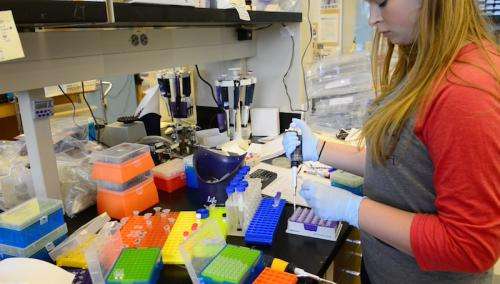Researcher develops, proves effectiveness of new drug for spinal muscular atrophy

According to recent studies, approximately one out of every 40 individuals in the United States is a carrier of the gene responsible for spinal muscular atrophy (SMA), a neurodegenerative disease that causes muscles to weaken over time. Now, researchers at the University of Missouri have made a recent breakthrough with the development of a new compound found to be highly effective in animal models of the disease. In April, a patent was filed for the compound for use in SMA.
"The strategy our lab is using to fight SMA is to 'repress the repressor,'" said Chris Lorson, a researcher in the Bond Life Sciences Center and professor in the MU Department of Veterinary Pathobiology. "It's a lot like reading a book, but in this case, the final chapter of the book—or the final exon of the genetic sequence—is omitted. The exciting part is that the important chapter is still there—and can be tricked into being read correctly, if you know how. The new SMA therapeutic compound, an antisense oligonucleotide, repairs expression of the gene affected by the disease."
In individuals affected by SMA, the spinal motor neuron-1 (SMN1) gene is mutated and lacks the ability to process a key protein that helps muscle neurons function. Muscles in the lower extremities are usually affected first, followed by muscles in the upper extremities, including areas around the neck and spine.
Fortunately, humans have a nearly identical copy gene called SMN2. Lorson's drug targets that specific genetic sequence and allows proper "editing" of the SMN2 gene. The drug allows the SMN2 gene to bypass the defective gene and process the protein that helps the muscle neurons function.
Lorson's breakthrough therapeutic compound was patented in April. His research found that the earlier the treatment can be administered in mice with SMA, the better the outcome. In mice studies, the drug improved the survival rate by 500 to 700 percent, with a 90 percent improvement demonstrated in severe SMA cases, according to the study.
Although there is no cure for SMA currently, the National Institutes of Health (NIH) has listed SMA as the neurological disease closest to finding a cure, due in part to effective drugs like the one developed in Lorson's lab.















